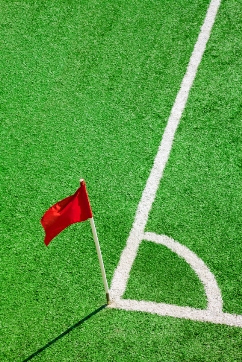One of the biggest hazards in outside field sports, yet often the most overlooked, is the field itself.
I know because I was once a victim of a poorly maintained field. During a college lacrosse game, I stepped into a hole, tearing my Anterior Cruciate ligaments and the menial meniscus cartilage in my right knee. My knee was so badly damaged it required two surgeries and months of casts and rehabilitation. I never played lacrosse again.

If only someone had taken a few moments to check the field before the game began, I probably would never have been injured.
Recent statistics suggest that as many as 25% percent of all soccer injuries result from poor field conditions. (Couture 2010).
While game officials are usually the ones responsible for inspecting a field before a game begins to ensure that it is in a playable condition, the reality is that, all too often, the referee barely arrives at the field in time for the game itself (if he or she shows at all!) and assumes that the coaches have inspected the field.
The coaches are so busy getting their team ready to play and giving last minute instructions that they also don't have time to check the field for holes, puddles, broken glass, stones or other debris. Most coaches are happy to leave this task to the ref, so they don't bother to check the field themselves.
Field Detail
The solution? Set up a field detail:
- Before the game: A parent should check the condition of the field, removing debris and eliminating any hazards. A reminder: that includes checking to see that the goalposts are securely anchored.
- After the game: When the game is over, the same parent should make sure that the field is left the way it was found, removing all litter from the field, sidelines and around the player benches.
- Setup a schedule: Assigning field detail to the parent bringing the water and orange slices to that week's game probably makes the most sense.
- Enlist coaches and players. Before starting practice or pre-game drills, the coach should check it from corner to corner (including the goals). The players can help too. That way they will learn how important it is to have a clean and safe playing surface.
According to an expert panel of the American Academy of Pediatrics (Koutures 2010), appropriate monitoring of field conditions, specifically holes or other irregularities, can reduce leg injuries in soccer.
The AAP's 2012 Policy Statement on Baseball and Softball also recommends regular inspection of baseball diamonds for hazards, including problems with sprinkler heads, gopher holes in the outfield, or rocky infields
Sources:
American Academy of Pediatrics; AAP Council on Sports Medicine and Fitness, Policy Statement: Baseball and Softball. Pediatrics. 2012;129(3):842-856. (doi: 10.1542/peds.2011-3593)(accessed February 26, 2012)
Koutures CG, Gregory AJM. Injuries in Youth Soccer. Pediatrics 2010;125:410-414.
Updated May 15, 2018








